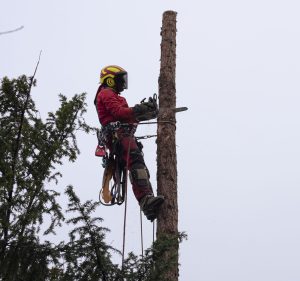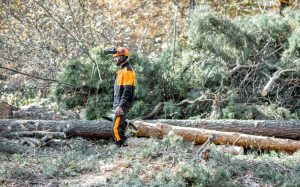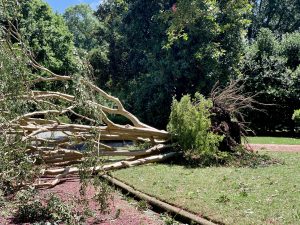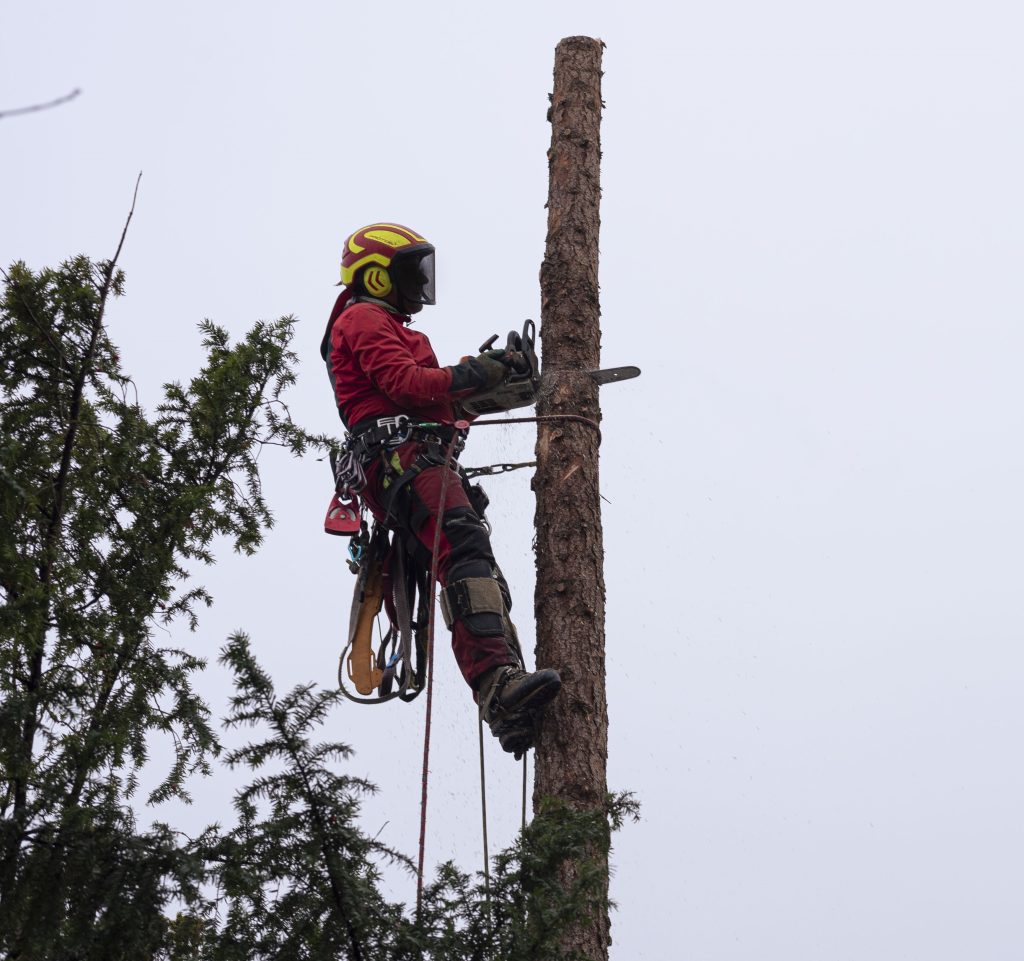Tree climbing is one of the most specialized skills in the tree care industry. Certified arborists use advanced techniques and equipment to safely reach branches high above the ground. This skill allows them to perform essential work such as pruning, storm damage cleanup, and full tree removals while keeping nearby homes, fences, and gardens safe from harm.
Why climbing is needed in tree care
Not every tree can be accessed by a bucket truck. Narrow yards, overhead utility wires, and delicate landscaping often make climbing the only practical option. Arborists climb when they need to:
- Remove dangerous limbs after storms

A worker cutting the tree with a special equipment - Prune overgrown branches threatening homes or power lines
- Reach trees in difficult or crowded spaces
- Carry out controlled removals without damaging property
Climbing ensures arborists can get to problem branches and sections of the tree that would otherwise remain out of reach.
Tools and techniques arborists use
Harnesses and ropes
Arborists wear specialized harnesses built for comfort and long hours in the tree. Ropes serve as the lifeline, giving them secure access to different points in the canopy.
Climbing knots and anchors
Knots like the Blake’s hitch or friction hitch allow arborists to ascend, descend, and position themselves safely. Anchors are tied to strong limbs to distribute weight and reduce strain on the tree.
Spur vs. rope climbing methods
- Spur climbing uses spiked boots to grip the trunk. This is mostly reserved for removals since the spikes puncture bark and can injure a living tree.
- Rope climbing avoids damage and is preferred for pruning, inspections, and ongoing care.
For those curious about the technical side, Tree Canada and resources like the Climbing Arborist guide outline industry practices and safety expectations in Ontario.
Safety protocols every arborist follows
Tree climbing is high-risk work, which is why training and protective gear are essential. Certified arborists follow strict safety standards:
- Wearing helmets, gloves, and eye protection
- Inspecting ropes and gear before each climb
- Maintaining three points of contact while ascending
- Setting up work zones and roping off danger areas
These measures protect the climber, bystanders, and the property itself. A professional won’t begin work until the site is secure and the plan is clear.
Benefits of hiring a certified arborist in London Ontario

If you’re searching for an arborist in London Ontario, hiring a certified professional is the best choice for both safety and results. Certified arborists:
- Work safely around power lines, roofs, and nearby structures
- Identify diseases, pests, and structural weaknesses in trees
- Prune with long-term health in mind, encouraging strong growth
- Carry insurance that protects homeowners in the rare case of accidents
DIY attempts may seem cost-saving at first, but they often lead to injuries, property damage, or a tree that never recovers. Professionals bring experience and protection you can rely on.
When to call London tree services 
It’s time to call a professional tree service if you notice:
- Overgrown branches touching your roof
- Trees leaning after heavy winds or storms
- Large dead limbs hanging over walkways or driveways
- Trees crowding power lines or neighbouring properties
Brockley Tree’s London tree services provide safe, professional solutions for homeowners and businesses across the region. If you spot a hazard, don’t wait—contact us for an inspection before the issue grows worse.
FAQs
How high can arborists climb?
With ropes and harnesses, arborists can safely reach over 100 feet if necessary.
Do arborists use ladders?
Rarely. Ladders are unstable at height. Professionals rely on climbing systems for safety.
Is tree climbing safe for the tree?
Yes, when done with rope systems. Spur climbing is used only during removals.
Can I climb my own tree?
It’s strongly discouraged. Without training and safety gear, the risks are severe. Always hire a certified arborist.
What should I do if a tree is leaning toward my house?
Call Brockley Tree immediately for an inspection and a safe removal plan.

